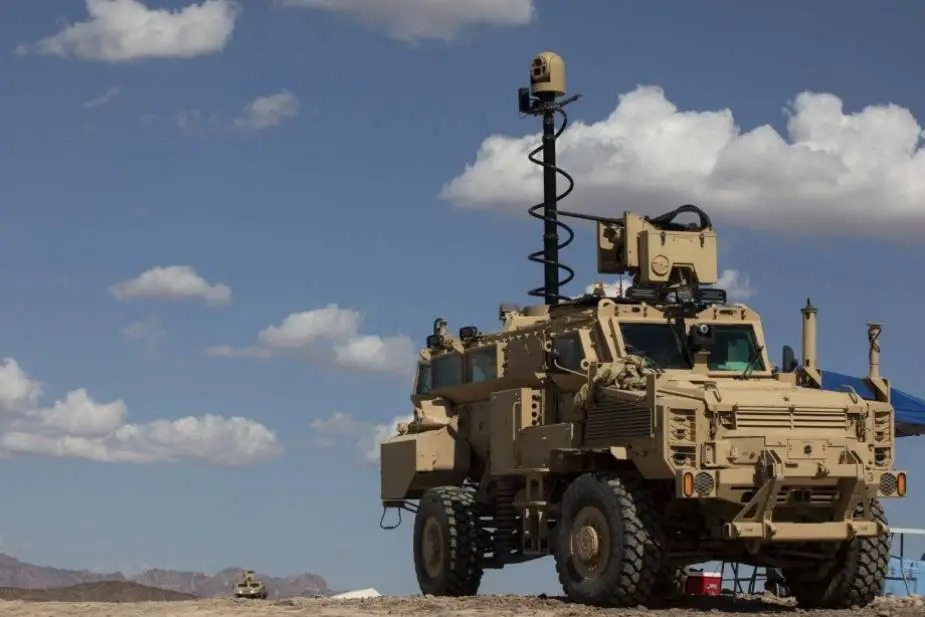US Army scales up joint capabilities as Project Convergence grows
The U.S. Army is ambitiously expanding efforts to develop and integrate joint force technologies needed in future warfare as part of Project Convergence, head of the Army’s Joint Modernization Command said on February 9. Thomas Brading, Army News Service, reports.
Follow Army Recognition on Google News at this link

The Next-Generation Combat Vehicle MRAP surrogate conducts a live-fire exercise during the Project Convergence capstone event at Yuma Proving Ground, Ariz., Aug. 11 to Sept. 18, 2020. (Picture source: U.S. Army/Spc. Carlos Cuebas Fantauzzi)
U.S. Army leaders have zeroed in on emerging technologies that could help the joint force achieve all domain operations, like new software, weapons, and tactical networks, said Col. Tobin Magsig during the virtual International Armored Vehicles Conference. Project Convergence is the Army’s contribution to the military-wide Joint All Domain Command and Control, or JADC2, concept, where data will link together land, air, sea, cyber and space capabilities.
Last year, the Army held its first Project Convergence series of exercises to test JADC2 tactics. As it comes more into focus, Army senior leaders are taking those lessons learned and applying them to future iterations, Magsig said. The first iteration, held at Yuma Proving Ground, Arizona, centered on the Army’s tactical fight : “[We’re] making sure the Army, as part of a joint and multinational force, can rapidly and continuously integrate emerging technologies and convert [them],” Magsig said, “through intelligence gathering, data sharing and interoperable systems to ensure we’re able to act more rapidly than our adversaries.”
For example, Army leaders believe the center of gravity behind joint operations comes down to tactical networking “and how we achieve the most amount of bandwidth and how we can ensure we have a resilient network that can pass data back and forth,” he said. Scaled up tactical networking capabilities will aid artificial intelligence-enabled systems on joint battlefields, with testing set to kick off in both a lab-based virtual environment and in the field. “When you put scientists with Soldiers together, that’s where the real learning occurs,” he said.
This is evident at the Joint Systems Integration Lab, or JSIL, at Aberdeen Proving Ground, Maryland, where some of those virtual tests are taking place, according to an Army news release. These tests hope to figure out ways to transmit more data with less bandwidth : “[JSIL] is basically where experimental networks [will] connect all our joint services, Army battle labs, and we’re able to integrate the technology in a distributed way,” Magsig said.
The JSIL plans to continue testing networking technologies ahead of Project Convergence 2021, slated to be held this fall again at Yuma. Although the missions are similar, the scale and execution will be much different. “When you put people in the dirt together for five weeks, you get real synergy out there and you [have] an opportunity to capture data,” he said. And “recode and rework algorithms at scale. This has caused us to relook at how we do talent management in our Army.”

Col. Tobin Magsig speaks during Joint Modernization Command's change of command ceremony on June 15 in front of its headquarters on Fort Bliss, Texas. (Picture source: U.S. Army/Cpl. William Dickinson)
In his experience, Magsig said groups with diverse backgrounds find better results. Especially in a field where technology has developed rapidly. Last year, Project Convergence 2020 was ambitious in its own right: connect any sensor with any shooter to destroy targets. But, compared to what’s ahead, Project Convergence 2020 was “very small,” Magsig said. “But we got out of it what we needed. So we’re going to increase complexity by focusing on multiple threads.”
This year, the project won’t be limited to nuanced thinkers from Army Futures Command. Units like the 82nd Airborne Division and the Army’s newest formation, the Multi-Domain Task Force, will play a role. “We’re going to have those commanders and their staffs run vignettes of [various] operational tasks,” he said. “We think it’s going to be powerful in terms of what we’ll learn and gain from unit insights instead of just Soldiers who live in this stuff every day.”
Besides those formations in the mix, the Army assembled a joint data collection team from the Army, Navy, Marine Corps, and Air Force. Every service, already integrated in yearlong testing efforts, are playing their part to connect everything, and will link every sensor across their system with any shooter to destroy virtually any target, he said.
By 2022, British and Australian militaries will be invited to take part in future iterations of Project Convergence, Magsig said in the virtual conference, which was made up largely of foreign troops. “We need to train and experiment alongside [our allies] to make sure the technology we’re developing is interoperable with the technology you’re developing,” he said. “We want to do this openly and transparently, then invite the UK and Australia to bring their technology and take part alongside us in Project Convergence 2022.”


























